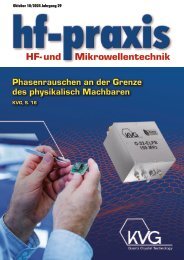12-2019
Fachzeitschrift für Hochfrequenz- und Mikrowellentechnik
Fachzeitschrift für Hochfrequenz- und Mikrowellentechnik
Sie wollen auch ein ePaper? Erhöhen Sie die Reichweite Ihrer Titel.
YUMPU macht aus Druck-PDFs automatisch weboptimierte ePaper, die Google liebt.
RF & Wireless<br />
Figure 3: The left picture shows one Wilkinson divider and the transmit module, which contains the phase shifter, attenuator, and a MMIC amplifier<br />
simulation techniques described<br />
in this paper do not depend on<br />
a specific EM simulator, since<br />
third-party simulated or measured<br />
S-parameter data can be<br />
used to represent the antenna<br />
response. The corporate feed<br />
network is shown in Figure 2.<br />
The power is input from the right<br />
side. Wilkinson dividers are used<br />
to split the signal and feed the 16<br />
patches. Figure 3 shows the feed<br />
Figure 4: 3D layout view of the designed MMIC amplifier<br />
for a typical patch. The transmit<br />
module and Wilkinson divider<br />
are shown in detail on the right<br />
side of Figure 3 and the inside of<br />
the transmit module on the left<br />
side. Each transmit module has<br />
a phase shifter, attenuator, and<br />
MMIC amplifier chip.<br />
The beam is steered by setting<br />
the phase and attenuation<br />
going into the MMIC amplifier<br />
and then sending the resulting<br />
signal to the patch. The phase<br />
and attenuation are controlled by<br />
variables in the software, which<br />
can be tuned and optimized as<br />
desired. In this manner, the beam<br />
can be scanned.<br />
Figure 4 shows the 3D view of<br />
the MMIC amplifier, which is<br />
a two-stage, 8-field effect transistor<br />
(FET) amplifier designed<br />
to work at X-band.<br />
In this example, the feed network<br />
is simulated entirely in the<br />
circuit simulator. A more realistic<br />
example would simulate the<br />
layout of the feed network in an<br />
EM simulator to make sure the<br />
models are accurate and there is<br />
no unintended coupling between<br />
sections of the network.<br />
Typical circuit simulation<br />
results are shown in Figure 5.<br />
The system is designed to work<br />
at 10 GHz. The purple curve<br />
shows the input impedance for<br />
an isolated patch from 6 to 14<br />
GHz on a 50 Ohm normalized<br />
Smith chart. The marker shows<br />
the normalized impedance at 10<br />
GHz. The four crosses show the<br />
input impedance of four typical<br />
elements at 10 GHz. Note<br />
that the interaction between the<br />
elements in the array shifts the<br />
input impedance of each element<br />
from that of an isolated<br />
patch. The green contours are<br />
load-pull simulations for the<br />
MMIC amplifier, showing the<br />
power delivered to a load. The<br />
shifting of the impedances of<br />
the antenna feed results in a 0.5<br />
dB degradation of power to the<br />
elements. (Figure 5 power contours<br />
are in 0.5 dB increments.)<br />
56 hf-praxis <strong>12</strong>/<strong>2019</strong>















